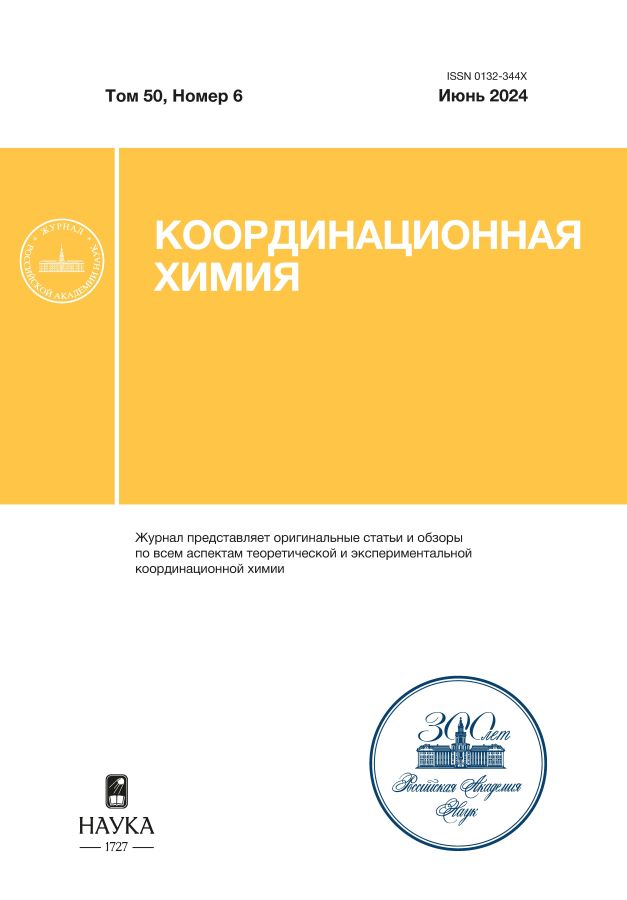Interaction of Lyophilic Zinc(II) Porphyrins with Bovine Serum Albumin
- Authors: Koifman O.I.1,2, Lebedeva N.S.1, Yurina E.S.1, Gubarev Y.A.1, Syrbu S.A.1,2, Kiselev A.N.1, Lebedev M.A.1,2
-
Affiliations:
- G.A. Krestov Institute of Solution Chemistry, Russian Academy of Sciences
- Ivanovo State University of Chemistry and Technology
- Issue: Vol 50, No 6 (2024)
- Pages: 374-384
- Section: Articles
- URL: https://rjonco.com/0132-344X/article/view/667592
- DOI: https://doi.org/10.31857/S0132344X24060034
- EDN: https://elibrary.ru/MVOYPS
- ID: 667592
Cite item
Abstract
Palladium-catalyzed heterylation of monobromophenyl-substituted zinc(II) porphyrin with small heterocycles (benzothiazole, benzoxazole, and N-methylbenzimidazole) was carried out. As a result, unsymmetrical heterylphenyl-substituted zinc(II) porphyrins soluble in organic solvents were obtained. The interaction of heteryl-substituted zinc(II) porphyrins with alpha-helical proteins was studied by spectral methods using bovine serum albumin in aqueous organic solvents. It was found that the titration of the zinc(II) porphyrins with albumin in a sodium phosphate buffer involves a number of equilibria including complexation and aggregation. In the case of porphyrins containing N-methylbenzimidazole and benzoxazole residues, self-aggregation processes initiated by absorption of organic solvent molecules by the protein predominate. It was found that more hydrophobic nature of zinc(II) porphyrin with benzothiazole residue promotes the complex formation with the protein. The photochemical properties of zinc(II) porphyrin with a benzothiazole residue, capacity for the photooxidation of the alpha-helical protein, and the high affinity of protein to this porphyrin make it a promising candidate for the potential applicability for photodynamic inactivation.
Full Text
About the authors
O. I. Koifman
G.A. Krestov Institute of Solution Chemistry, Russian Academy of Sciences; Ivanovo State University of Chemistry and Technology
Email: yurina_elena77@mail.ru
Russian Federation, Ivanovo; Ivanovo
N. S. Lebedeva
G.A. Krestov Institute of Solution Chemistry, Russian Academy of Sciences
Email: yurina_elena77@mail.ru
Russian Federation, Ivanovo
E. S. Yurina
G.A. Krestov Institute of Solution Chemistry, Russian Academy of Sciences
Author for correspondence.
Email: yurina_elena77@mail.ru
Russian Federation, Ivanovo
Yu. A. Gubarev
G.A. Krestov Institute of Solution Chemistry, Russian Academy of Sciences
Email: yurina_elena77@mail.ru
Russian Federation, Ivanovo
S. A. Syrbu
G.A. Krestov Institute of Solution Chemistry, Russian Academy of Sciences; Ivanovo State University of Chemistry and Technology
Email: yurina_elena77@mail.ru
Russian Federation, Ivanovo; Ivanovo
A. N. Kiselev
G.A. Krestov Institute of Solution Chemistry, Russian Academy of Sciences
Email: yurina_elena77@mail.ru
Russian Federation, Ivanovo
M. A. Lebedev
G.A. Krestov Institute of Solution Chemistry, Russian Academy of Sciences; Ivanovo State University of Chemistry and Technology
Email: yurina_elena77@mail.ru
Russian Federation, Ivanovo; Ivanovo
References
- Mancuso G., Midiri A., Gerace E. et al. // Pathogens. 2021. V. 10. P. 1310. https://doi.org/10.3390/pathogens10101310
- Urban-Chmiel R., Marek A., Stepie´n-Pysniak D. et al. //Antibiotics. 2022. V. 11. № 8. P. 1079. https://doi.org/10.3390/antibiotics11081079
- Ten threats to global health in 2019 // World Health Organization. 2019. V. 22. P. 2021. https://www.who.int/news-room/spotlight/ten-threats-to-global-health-in-2019
- Kenawy E.R., Worley S.D., Broughton R. // Biomacromolecules. 2007. V. 8. № 5. P. 1359. https://doi.org/10.1021/bm061150q
- Stojiljkovic I., Evavold B.D., Kumar V. // Expert opinion on investigational drugs. 2001. V. 10. № 2. P. 309. https://doi.org/10.1517/13543784.10.2.309
- König K., Teschke M., Sigusch B. et al. // Cellular Mol. Biol. 2000. V. 46. № 7. P. 1297.
- Lebedeva N.S., Gubarev Y.A., Koifman M.O. et al. // Molecules. 2020. V.25. P. 4368 https://www.mdpi.com/1420-3049/25/19/4368
- Lebedeva N.S., Koifman O.I. // Russ. J. Bioorg. Chemi. 2022. V. 48. №. 1. P. 1. https://doi.org/10.1134/S1068162022010071
- Koifman O.I., Ageeva Т.А., Beletskaya I.P. et al. // Macroheterocycles. 2020. V. 13. № 4. P. 183. https://doi.org/10.6060/mhc200814k
- Koifman O.I., Ageeva T.A., Kuzmina N. S. et al. // Macroheterocycles. 2022. V. 15. № 4. P. 207. https://doi.org/10.6060/mhc224870k
- Kiselev A.N., Lebedev M.A., Syrbu S.A. et al. // Russ. Chem. Bull. V. 71. № 12. P. 2691. https://doi.org/10.1007/s11172-022-3698-5
- Lebedeva N.S., Yurina E.S., Gubarev Y.A. et al. //Mendeleev Commun. 2017. V. 27. № 1. P. 47-49. https://doi.org/10.1016/j.mencom.2017.01.014
- Lebedeva N.S., Yurina E.S., Gubarev Y.A. et al. // J. Inclus. Phenom. Macrocycl. Chem. 2019. V. 95. № 3–4. P. 199. https://doi.org/10.1007/s10847-019-00947-1.
- Yurina E.S., Gubarev Y.A., Kiselev A.N. et al. // Mendeleev Commun. 2020. V. 30. № 2. P. 211. https://doi.org/10.1016/j.mencom.2020.03.027
- Lebedeva N.S., Yurina E.S., Gubarev Y.A. et al. // Spectrochim. Acta. A.2021. V. 246. P. 118975. https://doi.org/10.1016/j.saa.2020.11897.5
- Lebedeva N.S., Yurina E.S., Gubarev Y.A. et al. // Russ. J. Gen. Chem. 2019. V. 89. P. 565. https://doi.org/10.1134/S1070363219030368
- Ogunsipe A., Nyokong T. // J. Mol. Struct. 2004. V.689. P.89. https://doi.org/10.1016/j.molstruc.2003.10.024
- Ormond A.B., Freeman H.S. // Dyes Pigments. 2013. V. 96. № 2. P. 440. https://doi.org/10.1016/j.dyepig.2012.09.011
- Figueiredo T.L.C. Johnstone, R. A., Sørensen, A.M.S. et al. // Photochem. Photobiol. 1999. V. 69. № 5. P. 517. https://doi.org/10.1111/j.1751-1097.1999.tb03322.x
- Lebedeva N.Sh., Mal´kova E.A., Gubarev Yu.A., et al. Uch. Zap. Petrozavodsk. Gos. Univ. 2014 vol. 1. № 8 (145). P. 12.
- Rothemund P., Menotti A.R. // J. Am. Chem. Soc. 1948. V. 70. № 5. P. 1808. https://doi.org/10.1021/ja01185a047
- Kiselev A.N., Syrbu S.A., Lebedeva N.Sh. et.al. // Inorganics. 2022. V. 10. № 63. P. 1. https://doi.org/10.3390/inorganics10050063
- Akins D.L., Özçelik S., Zhu H. R. et al. // J. Phys Chem. 1996. V. 100. № 34. P. 14390. https://doi.org/10.1021/jp961013v
- Ghosh M., Nath S., Hajra A. et al. // J. Lumin. 2013. V. 141. P. 87. https://doi.org/10.1016/j.jlumin.2013.03.025
Supplementary files















